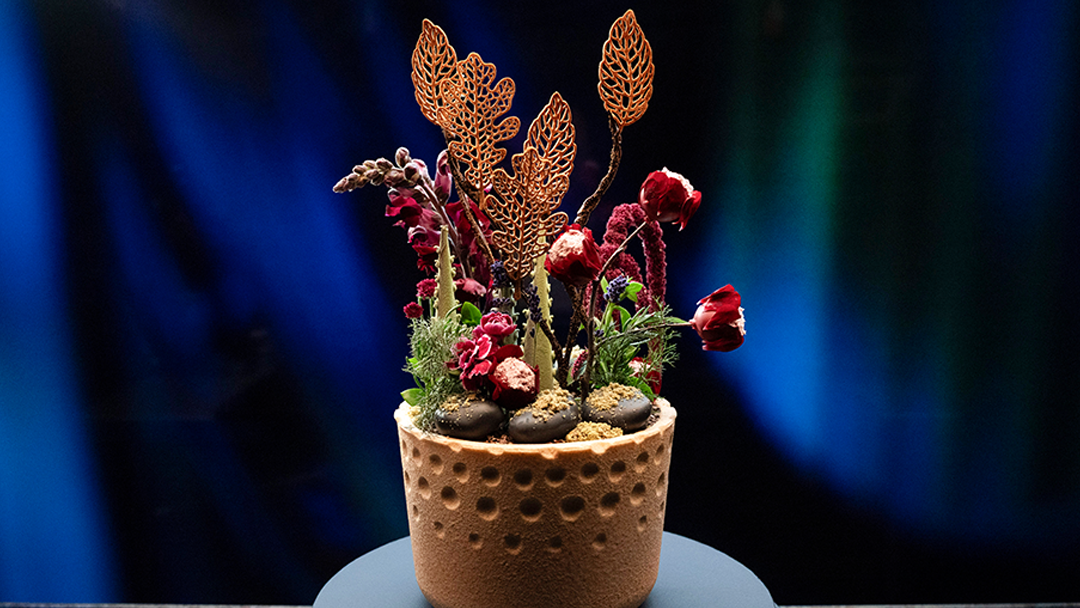Back
Botanical Garden

- Steps
- Ingredients
Ingredients
Profiterole
Crème Anglaise
Earl Grey Mousse
Gourmand Glaze
Mandarin Ganache
Moss Crumble
Raspberry Ganache
Aloe Vera Gel
Black Chocolate Dip
Pebble Assembly
Chocolate Cones
Chocolate Twigs
Aloe Vera Spikes
Lollipop Dust
Spray Aloe Vera
Tuile Leaves
Lollipop Chocolate Coating
Lollipop Flower Assembly
Assembly of Botanical Garden
Select All
Steps
- Preheat combi oven to 190°C, fan level 1, reverse cycle.
- Prechill blast freezer to - 40°C.
- Preheat dehydrator to 35°C. Place 2 x IAWATA spray guns inside.
Profiterole
- Line a large baking sheet with a silicon mat.
- For the Profiterole, in a medium saucepan over high heat, place butter, water, milk, salt and sugar and bring to the boil.
- Once boiling whisk in flour until well incorporated.
- To incorporate air into the mix and to create a soft dough, using a wooden spoon, stir the base of the pan with an up, down, and around motion. Continue to cook the flour for approximately 2-3 minutes until glistening. A thin film should form on the bottom of pan.
- Then, transfer cooked dough to the bowl of a stand mixer fitted with a paddle attachment. Mix on medium speed for 4-5 minutes to cool the dough to 35°C, scraping down the sides as required.
- Once cooled, add in eggs one at a time. Scrape sides and bottom of bowl with every addition.
- Transfer profiterole mix into a piping bag, fitted with a 1cm round nozzle.
- Pipe at least twenty, 3g rounds onto the baking sheet leaving 2cm between each.
- Pat down the peaks of each piped round with a wet finger to even out the shape.
- Bake profiterole at 190°C, fan 1 reverse cycle for 9 minutes, then reduce temperature to 150°C, briefly opening the door a little to reduce the temperature. Continue to bake at 150°C for 6 minutes then leave the door ajar for 1 minute with the profiteroles still inside.
- Remove profiteroles, and set aside to cool at room temperature.
Crème Anglaise
- For the Crème Anglaise, in a small saucepan over medium heat, bring milk to a simmer.
- Add the Earl Grey tea to the simmered milk and reduce heat to low, allowing the tea to steep for 8 minutes, stirring from time to time.
- Weigh egg yolk/sugar mixture into a small metal bowl.
- Remove tea from heat, and strain with a small sieve into a medium jug, topping up to reach 250g with whole milk if required.
- Whisk half the volume of the infused milk into the egg yolk/sugar mixture to temper the mix. Transfer the mixture back into the remainder of the hot infused milk, whisking well until incorporated.
- Return saucepan to low heat and stir using a wooden spoon until mixture is thick and approximately 85°C. Perform the nappe test to check readiness.
- Using a small fine sieve strain 75g of the crème anglaise into a small bowl. Then add gelatine mass, whisking well until dissolved, and set aside at room temperature. Discard remaining crème anglaise.
Earl Grey Mousse
- For the Earl Grey Mousse, melt Manjari dark chocolate in a microwave safe bowl in the microwave in 30 second increments, stirring in between to approximately 40°C.
- In the bowl of a stand mixer fitted with the whisk attachment, semi-whip the cream.
- Gradually pour the melted chocolate over the crème anglaise/gelatine mixture, whisking to combine to a smooth homogenous mixture that is 30-35°C. Add a tablespoon of semi-whipped cream to temper the mixture if required.
- Once mixture is smooth, and 30-35°C, stir through the remainder of the semi-whipped cream. The mixture should be a loose, soft mousse.
- Half fill a piping bag with the mousse, fitted with a 8mm round nozzle.
- Once profiteroles have cooled, pierce holes in the flat base of at least 5 profiteroles with an 8mm piping nozzle. Profiteroles can be placed in blast freezer to cool if required.
- Completely fill at least 5 profiteroles with mousse through the hole in the flat base, allowing the mousse to spill over slightly. Place in a bowl that will hold them hole side up to keep the filling in place.
- Transfer to the blast freezer to set firm until required.
Gourmand Glaze
- Line a large baking tray with baking paper.
- For the Gourmand Glaze, place Manjari dark chocolate and cocoa butter in a microwave safe bowl. Microwave until 45°C in 30 seconds intervals, stirring in between.
- Stir until cocoa butter is melted and the mixture is well combined. Transfer to a glass jar.
- Skewer the round top of a filled profiterole and dip into the gourmand glaze, coating completely. Tap to remove excess glaze.
- Transfer glazed profiterole to the lined tray, base down and remove skewer. Repeat with remaining then transfer tray of glazed profiterole to the fridge to set.
Mandarin Ganache
- Prepare a large baking sheet set with the pebble mould.
- For the Mandarin Ganache, place the Guanaja dark chocolate into a microwave safe bowl and microwave in 30 seconds intervals, stirring in between until approximately 50% melted.
- In a small saucepan over medium high heat, heat the cream and glucose to a simmer, approximately 60-65°C. Then add the mandarin zest.
- Pour half the cream mixture onto the partially melted chocolate. Mix well with a spatula. Transfer to a stick blender cannister, add the rest of the cream, and blitz to emulsify.
- Once the ganache is 35-40°C, add the butter, and blitz again. The ganache should be (32-34°C).
- Transfer to a large piping bag and snip the top.
- Pipe at least 5 pebble moulds filling to a third with mandarin ganache, using a spoon to push the ganache up the sides to create an even thin layer around the base and sides.
- Trim any excess gourmand glaze from the profiteroles.
- Push set glazed profiteroles flat side up into the mandarin ganache lined pebble moulds and fill any gaps inside the moulds with ganache. It is ok if the flat bases of the profiteroles are protruding slightly.
- Place pebble moulds in blast freezer to set for approximately 30 minutes.
Moss Crumble
- Change oven temperature to 160°C, fan 1 reverse cycle.
- Line a large baking sheet with a silicon mat.
- For the Moss Crumble, in a small bowl whisk together all dry ingredients to remove any lumps.
- Then, add butter and use fingertips to massage mixture until it becomes crumbly and resembles moist soil.
- Transfer the mixture to prepared tray, spread in a single even layer.
- Bake at 160°C, fan 1 reverse cycle, for approximately 6 minutes.
- Break up any large clumps and mix smaller crumbs with larger crumbs to create a natural looking "moss" crumble. Set aside at room temperature.
Raspberry Ganache
- Assemble a 2-piece silkomart sphere, ensuring the two parts are completely clicked together, and tightly wrap mould with cling wrap. With the tip of a knife pierce the fill holes large enough to pipe through, and place on a small baking tray.
- For the Raspberry Ganache, in the cannister of a stick blender, microwave the Raspberry Inspiration chocolate in 30 second increments to 45°C (approximately half melted).
- In a small copper saucepan whisk together the remaining ingredients and place over high heat to 104°C.
- Remove from heat, place briefly over an icebath and allow to cool to approximately 75-80°C.
- Pour raspberry purée mixture onto the half melted chocolate, use a stick blender to emulsify the mixture.
- Transfer ganache into a piping bag fitted with a 6mm nozzle and fill the sphere moulds to the brim.
- Tap moulds to level. Transfer to blast freezer to set completely until required.
Aloe Vera Gel
- For the Aloe Vera Gel, in a bowl whisk together sugar and agar agar powder.
- In a small saucepan over high heat, place aloe vera juice pulp and calamansi juice, and bring to the boil.
- Add sugar and agar agar mixture, whisk well to combine, then return to the boil.
- Transfer to a stick blender cannister and blitz until smooth.
- Transfer into a takeaway container then allow to set in the blast freezer for approximately 15 minutes. Reserve cannister.
- Once set, transfer aloe mixture back into cannister, and blitz until creamy and smooth. Transfer into a piping bag, set aside in fridge.
Black Chocolate Dip
- For the Black Chocolate Dip, place plain cocoa butter in a stick blender cannister. Microwave to approximately 50°C in 30 seconds intervals, stirring in between.
- Add tempered Opalys white chocolate to melted cocoa butter and blitz to incorporate.
- Warm black cocoa butter in the microwave until melted, add to white chocolate mixture and blitz to combine.
- Transfer black chocolate dip to a glass jar, set aside at room temperature and use at 34°C.
Pebble Assembly
- Line a small baking tray with baking paper.
- To finish the Pebbles, remove pebbles from moulds and trim away any excess dip from the base with a small paring knife.
- Ensure the black chocolate dip is ready at 34°C, using heat gun if required. Have the moss at hand.
- You will need to work quickly. Insert a skewer into the top of each pebble, then dip and swirl each into the black chocolate dip, tapping the skewer on your finger over the jar to remove excess coating.
- Quickly sprinkle the top with moss, place on lined tray and remove skewer, then cover hole with additional moss. Allow pebbles to set on the lined tray at room temperature.
Chocolate Cones
- Place a pre-filled 1/6 gastronorm tray of rice on the bench.
- To temper the chocolate, in a microwave safe bowl, microwave 330g of the Satillia Noire chocolate in 30 second increments to 50°C, stirring in between.
- Add chopped chocolate to the melted chocolate, stir vigourously with a spatula to combine and temper to 30°C.
- Fill two small piping bags approximately 2/3 full and seal. Set aside in the dehydrator until required.
- Use the remaining chocolate in the bowl to make the Chocolate Cones. First, place at least 3 acetate cones, pointy end down, into the pre-filled 1/6 gastronorm tray of rice.
- Transfer chocolate into a large piping bag and fill cone to the top with tempered dark chocolate, and then return to rice bowl to set for up to 2 minutes.
- Then, tip cone upside down over the tempering bowl allowing the excess chocolate to spill out. Return chocolate cone to rice, pointy end down, and allow to set at room temperature. 3 chocolate cones will be required for the finished pot.
- Repeat with other acetate cones.
- Transfer remainder of tempered chocolate to the dehydrator, to use if required.
Chocolate Twigs
- For the Chocolate Twigs, remove a small piping bag from dehydrator. Before piping, the chocolate texture should be thick enough that it holds shape when piped, but is still flowing, approximately 27°C.
- Prepare a marble board on the bench with a sheet of guitar acetate placed on top. Slide 2 twig templates underneath the guitar sheet. Place a small pinch bowl of ground wattleseed nearby.
- Line a large baking tray with baking paper.
- Snip the very tip of the piping bag of tempered chocolate to make a 1mm hole. When piping the tip of the twig, aim to end in an organic point, not a dot. Note: If the chocolate sets at the tip of the piping bag, use a heat gun to warm the tip, then push out and discard that portion from the piping bag as it will no longer be in temper.
- Pipe 1 single, 1mm line along the T1 twig template, then repeat process with the T2 and T3 twigs. You will require one of each.
- Return to T1 template and pipe another fine line over the top to create an irregular texture resembling a rope-like branch. Continue with T2 and T3 templates. Then repeat the process 2 more times to create 4 layers.
- Sprinkle the wet final layer of chocolate twig with the wattleseed, avoiding the tips of the branches. Allow to set for 2-3 minutes at room temperature.
- Return piping bag to dehydrator until required again.
- Once set, one chocolate twig at a time, use a large offset palette knife and carefully peel away the guitar sheet and carefully flip the twig over to it’s other side onto a clean section of guitar sheet. Again, with the chocolate at 27°C, apply two more fine 1 mm ropey lines on top of the set chocolate to create strength, structure and a rope-like texture to the chocolate twigs, then sprinkle with the wattleseed whilst still wet, again avoiding the last centimetre at the top of the branches.
- Set aside on lined tray at room temperature.
Aloe Vera Spikes
- To make the Aloe Vera Spikes, once chocolate cone has set, fill each with aloe vera gel then seal by piping a final 3mm layer of tempered chocolate over the surface. Use a small offset palette knife to flatten, ensuring it is smoothed over and flat and stable enough to stand upright. Transfer to the fridge to set.
- Place the cocoa butter in the cannister of a stick blender. Microwave in 30 second increments, stirring in between, until 50°C and melted.
- Remove the lid of the green chocolate colouring and melt in it’s bottle in the microwave in 15 second increments.
- Remove a piping bag of tempered chocolate from dehydrator, allow to cool to approximately 26°C, at which point the chocolate should be pasty but fluid enough to pipe the thorn detail on the aloe vera.
- Meanwhile, place 150g each of cocoa butter in two separate stick blender cannisters and set aside.
- For the yellow spray, add white titanium (A) and yellow powder to one cannister containing cocoa butter and blitz together with the stick blender.
- For the green spray, add the melted green chocolate colouring, white titanium (B) and transfer 7g of yellow cocoa butter to the melted plain cocoa butter cannister and blitz together until a uniform green colour. Set aside.
- The sprays should be used at approximately 35-40°C.
- Release the aloe vera filled cones from the the acetate moulds by running a blade along the tape line to cut.
- Space the 3 or 4 cones evenly in a line, pointy end down, in the pre-filled 1/6 gastronorm tray.
- Working down the right sides of the chocolate cones in a line, using the 26°C chocolate, pipe from base to tip, 5mm apart to resemble the thorns of an aloe vera plant. Then repeat on the opposite side. Allow to semi-set, then turn the spikes onto their bases and finish piping the thorns at the tip. Place in the fridge for up to 10 minutes before spraying to chill.
Lollipop Dust
- For the Lollipop Dust, sift together in a bowl the icing sugar, strawberry gum powder and raspberry powder, then whisk through maltodextrin.
- Slowly add grapeseed oil while using your fingers to lightly crumble and mix the ingredients together until incorporated. Do not over mix.
- Transfer to a takeaway container. Set aside at room temperature and keep sealed until required.
Spray Aloe Vera
- Transfer the tray of aloe spikes and the coloured cocoa butters to the spray booth.
- Fill the chamber of warm IAWATA airbrush with yellow spray and, spraying a line in a continuous up/down motion to the left side of each aloe spike, spray up/down 4 times. Then turn the tray 90°C and repeat, spraying to the left side again. Return any excess spray to the cannister.
- Next re-fill the cannister of the IAWATA airbrush with green spray colour and, spraying a line in an up/down motion to the left side of each aloe spike, spray to mostly cover the yellow base. Spray up/down 2 to 3 times. Then turn the tray 90°C and spraying to the left (but opposite) side again, repeat the process. Return any excess spray to the cannister.
- Set aside to dry at room temperature.
Tuile Leaves
- Change combi oven temperature to 160°C, fan 4 reverse cycle.
- Line a large baking sheet with baking paper. Add both the plain leaf and oak leaf tuile moulds.
- For the Tuile, in a mini chop blender place all ingredients and blend until smooth.
- Fill the tuile mould using a small offset spatula. At least 3 plain leaves and 2 oak leaves will be required.
- Bake at 160°C, Fan 4 reverse cycle, for approximately 9 minutes until golden and cooked through.
- Remove baking sheet and immediately unmould the tuile leaves using a tweezer.
- Set aside to cool at room temperature on the lined tray.
Lollipop Chocolate Coating
- For the Lollipop Chocolate Coating, temper the raspberry chocolate. In a microwave safe bowl, microwave 130g of the raspberry chocolate in 30 second increments to 45-50°C, stirring in between.
- Reduce the temperature down to 29°C by adding the chopped raspberry chocolate and stirring to thoroughly combine.
- In another microwave safe bowl, microwave to melt the cocoa butter to 50°C.
- Incorporate melted cocoa butter into raspberry chocolate mixing well with a spatula.
- Transfer lollipop chocolate coating to a glass jar and place in dehydrator until ready to dip at 37-40°C.
Lollipop Flower Assembly
- Prepare a metal rack over a large baking tray.
- Ensure lollipop chocolate coating is ready to dip at 37-40°C. Have the lollipop dust and red geranium petals at hand.
- Unmould at least 5 raspberry ganache spheres, rolling around your palms to get a perfect sphere shape.
- To create the raspberry lollipop flowers, skewer the raspberry ganache sphere and dip into the lollipop chocolate coating. Tap the skewer on your finger over the jar to remove excess coating, then quickly dip only the tip into the lollipop dust.
- To create the look of a flower with the raspberry lollipop and the lollipop dust as pollen, dip the flat paddle edge of a skewer into the chocolate coating and, with darker side of the red geranium petal facing out, glue the centre of the petal to the midline of the raspberry lollipop. Stick approximately 8 large petals around, creating a full looking flower.
- Rest finished skewers holding lollipop flowers through mesh of metal rack to hold upright. Repeat to achieve 5 lollipop flowers.
- Once set, lift rack and remove skewers from underneath.
Assembly of Botanical Garden
- Place the pre-filled sprayed chocolate pot on serving board. Have twig template on hand for reference.
- Note: all twigs and flower stems need to be dug deep into the cacao nibs for stability.
- Position the chocolate twigs starting with T2 in the centre of the pot, orient the tallest branch in the centre and the shorter branch angling off to the right. Push low into the pot.
- Position T1, 1 inch behind and 1 inch to the left of T2.
- Then, position T3, 1 inch behind and 2 inches to the right of T2, with the tall branch leaning to the right.
- To place the strawberry gum twig, orient branches leaning towards the right side of the pot, position 1 inch from the front of the pot and in line with the right branch of the T2 (centre) twig.
- Place 3 pebbles around the front rim of the pot at 6 O’clock, 8 O’clock and to the right of the strawberry gum branch at 4 O’clock.
- Scatter a little pile of moss crumble to the left of the pebble at 4 O’clock and 8 O’clock.
- Place 2 pebbles touching the back rim of the pot at 12 O’clock and 1 O’clock.
- Wear gloves to position the sprayed aloe vera spikes, carefully pushing them into the cacao nibs for stability. Place a spike on the left, in front of the left (T1) chocolate twig. Place another spike to the left of it. Place the 3rd spike in front of and between the back two pebbles.
- Utilising the holes left by the skewers, firmly skewer a lollipop flower onto the top, middle and shortest branches of the strawberry gum twig, ensuring they are secured in place.
- To fix the tuile to the chocolate twigs, pipe a blob from the piping bag of warm tempered chocolate as ‘glue’onto the chocolate twig, use cool spray to assist with adhering, then pipe another blob of glue to reinforce:
- Pointing the leaf slightly to the right, stick one plain leaf to the right hand tip of the right (T3) chocolate twig.
- Pointing leaf upright, stick one plain leaf to the left stem of T3 (right) twig.
- Pointing leaf upright, stick one plain leaf to the tip of the left (T1) twig.
- Then glue one upright oak leaf halfway up the left hand branch of T2 (central) twig.
- Then ‘glue’ one oak leaf angling to the left, 2.5 inches from the base of the T2 (centre) twig, slightly overlapping the oak leaf above.
- Place one sprig of winter purslane behind the left hand aloe vera spike, then dig a snapdragon stem in behind it. Place a red chrysanthemum sprig to the left of the winter purslane.
- Place a winter purslane sprig between the T2 (centre) and T3 (right) chocolate twig. Place a red amaranth sprig, hanging to the right, behind it.
- On the right side of pot, position a sprig of bronze fennel in front of the winter purslane. Place a sprig of sea blite immediately on the right of it.
- Place a sprig of bronze fennel in front of the two left side aloe vera spikes and place a sprig of sea blite left of it.
- Place 2 tall sprigs of English lavender at the base to the left of the centre chocolate twig (T2). Place a cluster of 2 pink dianthus flowers to the left of this lavender.
- Place a small sprig of lavender behind the front right pebble.
- Place a lollipop flower on the back right at 2 O’Clock. Then place the 5th lollipop flower resting on top towards the back of the central and front left pebble.
- Scatter a little pile of moss crumble in the middle of the pot, at the back of the pot between the back pebbles, and around the base of the far left aloe vera spike.




















